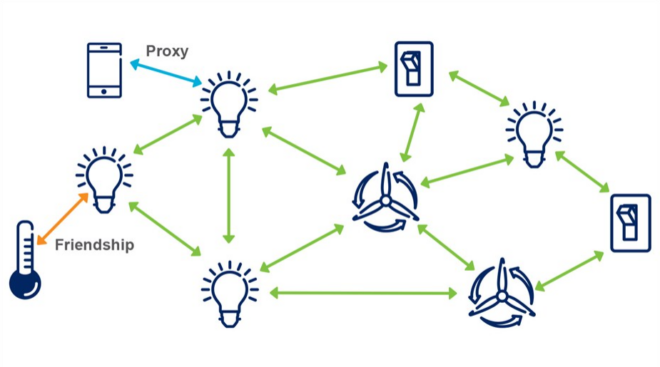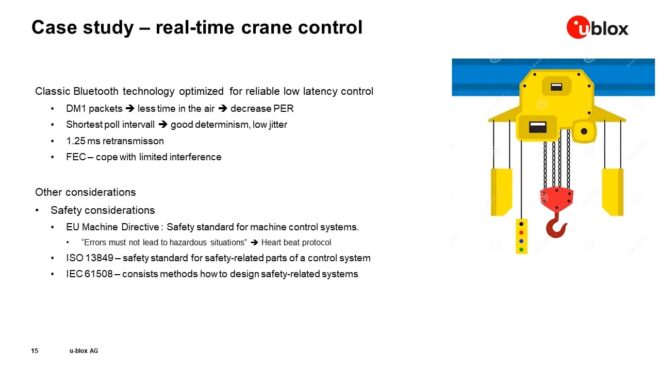One of the biggest challenges for any wireless technology in providing reliable data communication is interference. Unlike wired data communications technologies, wireless technologies must share the transmission medium and multiple devices may try to communicate over the same wireless spectrum, in the same general area, and at the exact same time. When this happens, in-air collisions between data packets occur which can make a packet unreadable by the receiving device and effectively lost.
This challenge is especially true in unlicensed spectrum bands, such as the global ISM band, where a communications technology needs to accommodate potential interference from other devices using the same communications technology, as well as devices using other communications technologies that operate in the same band.
Channels that are noisy and busy are dynamically tracked and avoided.
For example, Bluetooth® technology operates in the same 2.4 GHz ISM frequency band as Wi-Fi and technologies that utilize the IEEE 802.15.4 standard. As a result, it’s possible for a packet being transmitted between two Bluetooth devices to be corrupted or lost if it collides with a packet being transmitted at the exact same time and frequency channel between other in-range Bluetooth, Wi-Fi, or 802.15.4 devices. Other devices utilizing the 2.4 GHz band can also cause unwanted electromagnetic noise in the environment, including lights, microwave ovens, baby monitors, and garage door openers, to name just a few.
There are many techniques for mitigating interference. For a detailed discussion on the mitigation techniques, Bluetooth technology uses to increase reliability, check out Martin Woolley’s paper on Understanding Reliability in Bluetooth Technology. In this article, we will look at how Bluetooth technology overcomes potential interferers and enables reliable wireless data communication by using adaptive frequency hopping and small, fast data packets.
Small, Fast Packets
When trying to avoid collisions, it’s best to be small and fast. For example, when compared to other low-power wireless mesh networking technologies, Bluetooth® packets are typically half the size and four times faster. Having small, fast packets enables more efficient use of spectrum and significantly lowers the probability of collisions.
Bluetooth® packets are hard to hit.
As Szymon Slupik, CTO at Silvair and Chair of the Bluetooth Mesh Working Group, often says, the math is simple: the shorter the packet the fewer collisions. The reliability of any wireless system is all about spectral efficiency. According to Slupik, the size of Bluetooth Mesh packets is one of the biggest reasons why Bluetooth Mesh networking is “the first wireless standard capable of meeting the enormous expectations of the IoT era.”
Slupik is not alone in his praise for the packet. Woolley references the Bluetooth Mesh packet in relation to scalability and capacity of a high-density device network. As Woolley says:
The less radio airtime a packet requires, the lower the probability of a collision. The small packet size of Bluetooth® Mesh and the high symbol rate of the Bluetooth LE radio reduce the required airtime for a packet and means that Bluetooth Mesh networks fare well in this respect.
But Bluetooth packets don’t just have size and speed on their side. They’re also good at avoiding conflict.
Adaptive Frequency Hopping
Spread spectrum techniques can increase the resiliency of a wireless technology in busy radio environments where collisions and interference are more likely to occur. Adaptive Frequency Hopping is a unique spread spectrum technique Bluetooth technology utilizes to avoid interference.
To understand how Adaptive Frequency Hopping works, it helps to look at how Bluetooth technology divides the 2.4 GHz ISM band. First, like many wireless communication protocols, Bluetooth technology uses more than one radio channel. Bluetooth Low Energy (LE) divides the 2.4GHz ISM radio band into 40 channels, while Bluetooth BR/EDR divides it into 80 channels.
Bluetooth technology also hops between transmission channels to further decrease the probability of collisions with other in-range transmissions. Frequency hopping frees up more radio capacity for messages, making communication more reliable. Frequency hopping is not necessarily unique to Bluetooth technology. But what happens next is.
Adaptive Frequency Hopping adds intelligence to frequency hopping and enables Bluetooth packets to adapt to avoid active, congested channels. Channels that are noisy and busy are marked and not used. The list of reliable channels and busy channels can change quickly, as other wireless communication devices and noise in the environment come and go. Adaptive Frequency Hopping allows Bluetooth technology to dynamically track which channels are functioning best and find the most reliable path.
Bluetooth® packets avoid conflict.
Reliable by Design
As you can see, Bluetooth technology is capable of achieving highly reliable communication in even the most challenging circumstances. These two methods provide a glimpse into the techniques and features Bluetooth® technology offers to help developers address the challenge of interference. Reliability in Bluetooth technology is more than just the sum of the reliability of its parts; the technology was designed with reliability in mind. For a detailed discussion on the many mitigation techniques Bluetooth technology uses to increase reliability, download Understanding Reliability in Bluetooth Technology.
![]()
FEATURED
How Bluetooth® Technology Makes Wireless Communication Reliable
Learn about the challenge of wireless interference and the techniques Bluetooth technology uses to overcome it.


























